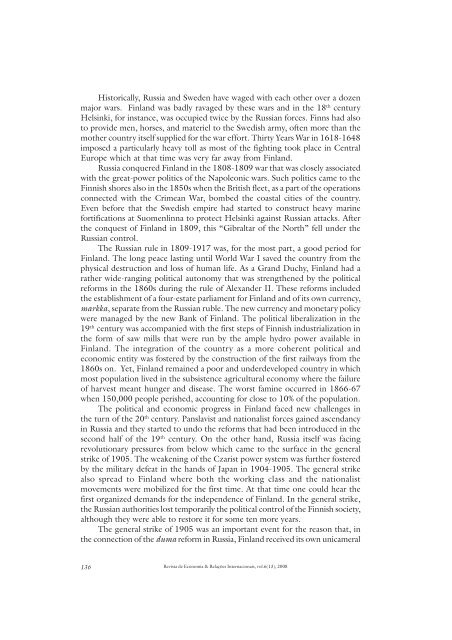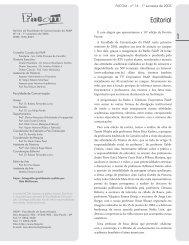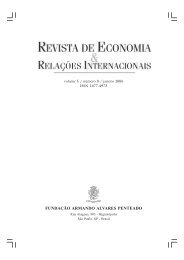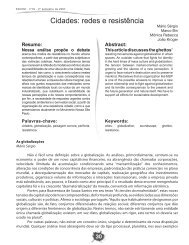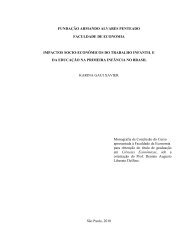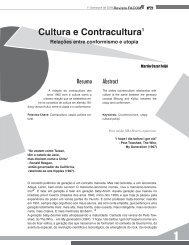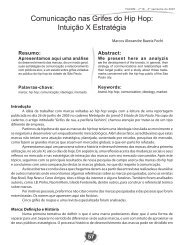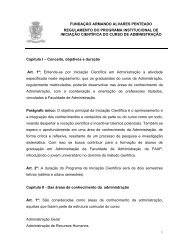Revista Economia n. 13.pmd - Faap
Revista Economia n. 13.pmd - Faap
Revista Economia n. 13.pmd - Faap
You also want an ePaper? Increase the reach of your titles
YUMPU automatically turns print PDFs into web optimized ePapers that Google loves.
Historically, Russia and Sweden have waged with each other over a dozen<br />
major wars. Finland was badly ravaged by these wars and in the 18 th century<br />
Helsinki, for instance, was occupied twice by the Russian forces. Finns had also<br />
to provide men, horses, and materiel to the Swedish army, often more than the<br />
mother country itself supplied for the war effort. Thirty Years War in 1618-1648<br />
imposed a particularly heavy toll as most of the fighting took place in Central<br />
Europe which at that time was very far away from Finland.<br />
Russia conquered Finland in the 1808-1809 war that was closely associated<br />
with the great-power politics of the Napoleonic wars. Such politics came to the<br />
Finnish shores also in the 1850s when the British fleet, as a part of the operations<br />
connected with the Crimean War, bombed the coastal cities of the country.<br />
Even before that the Swedish empire had started to construct heavy marine<br />
fortifications at Suomenlinna to protect Helsinki against Russian attacks. After<br />
the conquest of Finland in 1809, this “Gibraltar of the North” fell under the<br />
Russian control.<br />
The Russian rule in 1809-1917 was, for the most part, a good period for<br />
Finland. The long peace lasting until World War I saved the country from the<br />
physical destruction and loss of human life. As a Grand Duchy, Finland had a<br />
rather wide-ranging political autonomy that was strengthened by the political<br />
reforms in the 1860s during the rule of Alexander II. These reforms included<br />
the establishment of a four-estate parliament for Finland and of its own currency,<br />
markka, separate from the Russian ruble. The new currency and monetary policy<br />
were managed by the new Bank of Finland. The political liberalization in the<br />
19 th century was accompanied with the first steps of Finnish industrialization in<br />
the form of saw mills that were run by the ample hydro power available in<br />
Finland. The integration of the country as a more coherent political and<br />
economic entity was fostered by the construction of the first railways from the<br />
1860s on. Yet, Finland remained a poor and underdeveloped country in which<br />
most population lived in the subsistence agricultural economy where the failure<br />
of harvest meant hunger and disease. The worst famine occurred in 1866-67<br />
when 150,000 people perished, accounting for close to 10% of the population.<br />
The political and economic progress in Finland faced new challenges in<br />
the turn of the 20 th century. Panslavist and nationalist forces gained ascendancy<br />
in Russia and they started to undo the reforms that had been introduced in the<br />
second half of the 19 th century. On the other hand, Russia itself was facing<br />
revolutionary pressures from below which came to the surface in the general<br />
strike of 1905. The weakening of the Czarist power system was further fostered<br />
by the military defeat in the hands of Japan in 1904-1905. The general strike<br />
also spread to Finland where both the working class and the nationalist<br />
movements were mobilized for the first time. At that time one could hear the<br />
first organized demands for the independence of Finland. In the general strike,<br />
the Russian authorities lost temporarily the political control of the Finnish society,<br />
although they were able to restore it for some ten more years.<br />
The general strike of 1905 was an important event for the reason that, in<br />
the connection of the duma reform in Russia, Finland received its own unicameral<br />
136<br />
<strong>Revista</strong> de <strong>Economia</strong> & Relações Internacionais, vol.6(13), 2008


